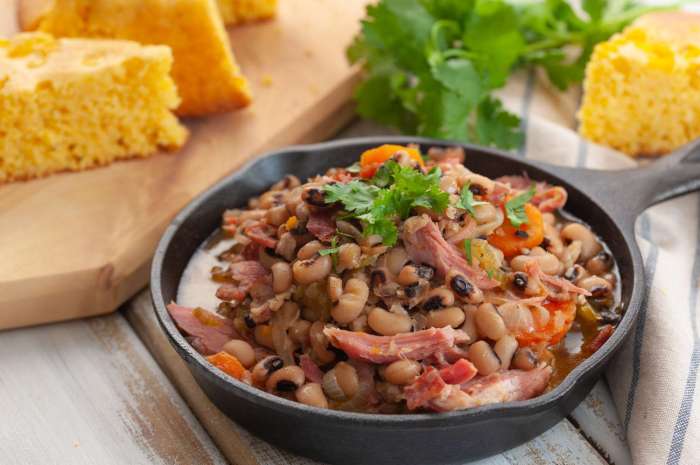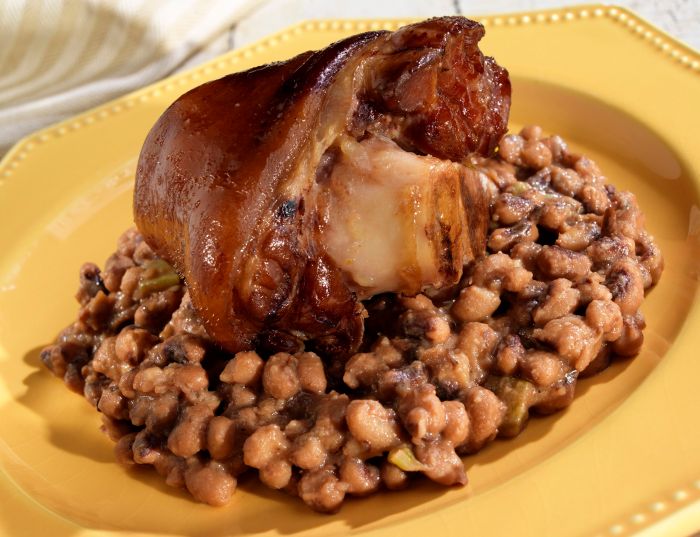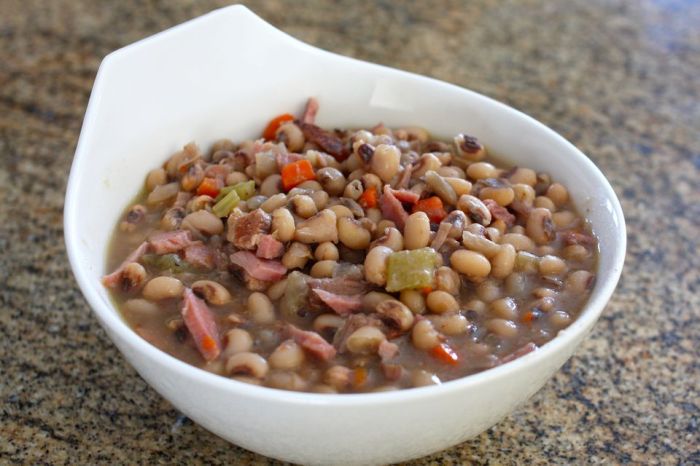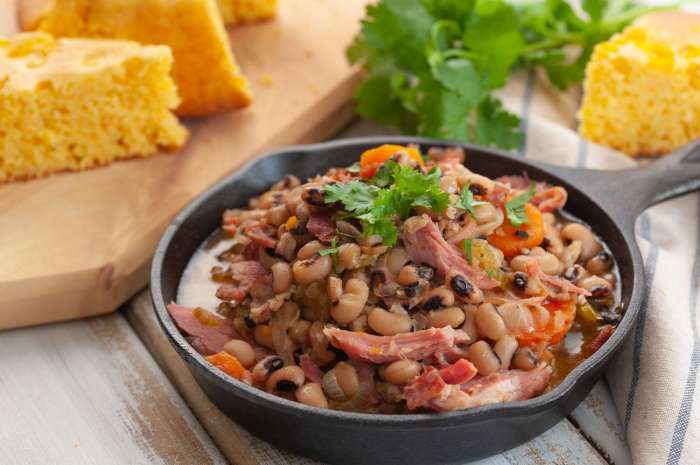
Black Eyed Peas and Ham Hocks: A Culinary Journey
Black eyed peas and ham hocks, a classic Southern comfort food, have a rich history and a captivating flavor that transcends regional boundaries. This dish, often served on New Year’s Day, is a symbol of good luck and prosperity, rooted in centuries of tradition.
From its humble beginnings to its evolution into a beloved staple, black eyed peas and ham hocks have a story to tell, a story that intertwines with cultural heritage, culinary creativity, and the simple pleasure of good food.
The dish’s origins can be traced back to the African diaspora, where black eyed peas were a vital source of sustenance. When enslaved Africans arrived in the American South, they brought their culinary traditions with them, adapting them to the local ingredients and creating dishes like black eyed peas and ham hocks.
Over time, this dish became a staple in Southern cuisine, and its popularity has spread far beyond the region, embraced by food lovers across the globe.
Culinary History and Origins
Black-eyed peas and ham hocks, a hearty and comforting dish, boast a rich history spanning continents and cultures. This seemingly simple combination has deep roots in the culinary traditions of various regions, evolving over time into a beloved staple.
Origins and Significance
The origins of this dish can be traced back to the African diaspora, where black-eyed peas, a legume native to Africa, were a key ingredient in traditional cuisine. During the transatlantic slave trade, enslaved Africans brought their culinary knowledge and traditions to the Americas, where black-eyed peas were readily available and cultivated.
The combination with ham hocks, a readily available protein source, likely emerged as a way to utilize both ingredients in a satisfying and nutritious meal.
Regional Variations and Traditions
Black-eyed peas and ham hocks have found a special place in the culinary landscape of various regions, each adding their own unique twist to the dish.
Southern United States
In the Southern United States, this dish is deeply ingrained in culinary traditions, particularly during the New Year’s holiday season. The dish is often referred to as “Hoppin’ John” or “Black-Eyed Pea Soup,” and is believed to bring good luck and prosperity in the coming year.
The dish is traditionally served with collard greens and cornbread, representing wealth, health, and prosperity.
The Caribbean
In the Caribbean, this dish is a common staple, often prepared with coconut milk and spices, creating a flavorful and aromatic stew. In Jamaica, it is known as “Gungo Peas and Salt Pork,” while in Trinidad and Tobago, it is called “Black-Eyed Peas and Pigtail.” These variations often incorporate regional spices and herbs, adding a unique flavor profile to the dish.
Africa
In Africa, black-eyed peas are a staple ingredient in many dishes, and their combination with various meats, including pork, beef, and chicken, is common. These dishes often incorporate regional spices and herbs, creating a diverse range of flavors and textures.
Brazil
In Brazil, black-eyed peas are a popular ingredient in the dish “Feijoada,” a hearty stew made with beans, pork, and other ingredients. While not always paired with ham hocks, the dish showcases the versatility of black-eyed peas in Brazilian cuisine.
Nutritional Value and Health Benefits

Black-eyed peas and ham hocks, a classic Southern dish, are not only delicious but also packed with essential nutrients. This hearty meal offers a blend of protein, fiber, vitamins, and minerals, making it a wholesome and satisfying choice.
Black eyed peas and ham hocks are a classic Southern comfort food, but sometimes you crave something a little lighter. That’s where a all american loaded baked potato salad comes in! It’s a refreshing change of pace, and the creamy potato base can actually be a great compliment to the smoky, savory flavors of black eyed peas and ham hocks.
Nutritional Breakdown
This dish is a source of several essential nutrients, including:
- Protein:Black-eyed peas and ham hocks provide a good amount of protein, which is crucial for building and repairing tissues, producing enzymes and hormones, and maintaining a healthy immune system.
- Fiber:Black-eyed peas are an excellent source of both soluble and insoluble fiber, which aids in digestion, helps regulate blood sugar levels, and promotes a feeling of fullness.
- Iron:Ham hocks are a good source of iron, a mineral essential for red blood cell production and oxygen transport throughout the body.
- Vitamin B:Black-eyed peas and ham hocks contain various B vitamins, including thiamin, riboflavin, and niacin, which are involved in energy production, cell growth, and nervous system function.
- Potassium:Ham hocks are a good source of potassium, an electrolyte that helps regulate fluid balance, muscle contractions, and nerve function.
Health Benefits
The combination of nutrients in black-eyed peas and ham hocks offers a range of potential health benefits:
- Heart Health:The high fiber content in black-eyed peas can help lower cholesterol levels and reduce the risk of heart disease.
- Blood Sugar Control:The fiber in black-eyed peas helps slow down the absorption of sugar into the bloodstream, which can help regulate blood sugar levels and reduce the risk of type 2 diabetes.
- Weight Management:The high fiber and protein content in this dish can promote a feeling of fullness, which can help control appetite and support weight management.
- Improved Digestion:The fiber in black-eyed peas helps promote regular bowel movements and can prevent constipation.
- Antioxidant Benefits:Black-eyed peas contain antioxidants that can help protect cells from damage caused by free radicals.
Dietary Considerations
While black-eyed peas and ham hocks offer a range of health benefits, there are some dietary considerations to keep in mind:
- Sodium:Ham hocks are naturally high in sodium, which can be a concern for individuals with high blood pressure or other health conditions. It’s important to choose lean cuts of ham hocks and to limit the amount of salt added during cooking.
Black eyed peas and ham hocks are a classic Southern comfort food, but sometimes you crave something lighter and brighter. For a refreshing change of pace, I love a greek green bean salad with feta and tomatoes , which brings a burst of Mediterranean flavors.
The tangy feta and juicy tomatoes complement the green beans perfectly, and it’s a great side dish for any meal, even a hearty black eyed peas and ham hocks pot.
- Purines:Ham hocks are also high in purines, which can be broken down into uric acid. Individuals with gout should limit their intake of purine-rich foods.
- Dietary Restrictions:Black-eyed peas and ham hocks are not suitable for individuals following a vegan or vegetarian diet.
Cooking Techniques and Variations
Black-eyed peas and ham hocks, a Southern culinary staple, offer a delicious and hearty meal. The versatility of this dish allows for various cooking techniques and ingredient variations, making it a culinary canvas for creativity.
Traditional Stovetop Method
The traditional stovetop method involves simmering the black-eyed peas and ham hocks in a pot of water until tender. This method allows for the flavors to meld and develop over time, resulting in a rich and savory broth.
- Rinse and pick over 1 pound of dried black-eyed peas, removing any debris or damaged peas. Soak the peas in cold water for at least 4 hours or overnight. This step helps to shorten the cooking time and ensures a more tender result.
- In a large pot or Dutch oven, combine the soaked black-eyed peas, 1 pound of smoked ham hocks, 8 cups of water, 1 onion quartered, 2 celery stalks chopped, and 2 bay leaves. Bring the mixture to a boil, then reduce heat to low, cover, and simmer for 1 1/2 to 2 hours, or until the peas are tender.
- Season the dish with salt and black pepper to taste. Remove the ham hocks from the pot and shred the meat. Return the shredded ham to the pot and serve hot.
Slow Cooker Method
The slow cooker method is a convenient option for preparing black-eyed peas and ham hocks, as it requires minimal hands-on time. The slow cooking process allows for the flavors to develop slowly, resulting in a deeply flavorful dish.
Black eyed peas and ham hocks are a classic Southern comfort food, but sometimes you crave something a little lighter. If you’re looking for a sophisticated and flavorful dish, you might consider a stuffed salmon with shrimp and crab , which is a great option for a special occasion.
However, when it comes to hearty, soul-satisfying meals, nothing beats a big pot of black eyed peas and ham hocks simmering on the stove.
- Rinse and pick over 1 pound of dried black-eyed peas, removing any debris or damaged peas. Soak the peas in cold water for at least 4 hours or overnight.
- In a slow cooker, combine the soaked black-eyed peas, 1 pound of smoked ham hocks, 8 cups of water, 1 onion quartered, 2 celery stalks chopped, and 2 bay leaves. Cover and cook on low heat for 6 to 8 hours, or on high heat for 3 to 4 hours, until the peas are tender.
- Season the dish with salt and black pepper to taste. Remove the ham hocks from the slow cooker and shred the meat. Return the shredded ham to the slow cooker and serve hot.
Pressure Cooker Method
The pressure cooker method offers a faster and more efficient way to cook black-eyed peas and ham hocks. The pressure cooking process helps to shorten the cooking time while retaining the flavors.
- Rinse and pick over 1 pound of dried black-eyed peas, removing any debris or damaged peas. Soak the peas in cold water for at least 4 hours or overnight.
- In a pressure cooker, combine the soaked black-eyed peas, 1 pound of smoked ham hocks, 8 cups of water, 1 onion quartered, 2 celery stalks chopped, and 2 bay leaves. Secure the lid and cook on high pressure for 25 minutes. Allow the pressure to release naturally for 10 minutes before releasing the remaining pressure manually.
- Season the dish with salt and black pepper to taste. Remove the ham hocks from the pressure cooker and shred the meat. Return the shredded ham to the pressure cooker and serve hot.
Variations on the Traditional Recipe
The traditional recipe for black-eyed peas and ham hocks can be adapted to suit individual preferences and dietary needs.
- Spices: Experiment with different spices to enhance the flavor profile. For a bolder flavor, add smoked paprika, cayenne pepper, or chili powder. For a more subtle flavor, try adding cumin, coriander, or thyme.
- Vegetables: Incorporate other vegetables for added texture and nutrients. Common additions include diced tomatoes, carrots, bell peppers, or greens like collard greens or mustard greens.
- Meat: While ham hocks are traditional, other smoked meats can be used as substitutes, such as smoked turkey legs or smoked sausage. For a vegetarian option, use vegetable broth and omit the meat altogether.
Cultural Significance and Traditions

Black-eyed peas and ham hocks are more than just a delicious dish; they hold deep cultural significance and are intertwined with various traditions and beliefs, particularly in the Southern United States. This dish, often associated with good luck and prosperity, plays a prominent role in celebrations and events, and its history is deeply rooted in African American heritage.
Superstitions and Beliefs
The tradition of eating black-eyed peas and ham hocks on New Year’s Day is a deeply ingrained practice in many Southern households. This tradition stems from the belief that consuming these foods brings good luck and prosperity in the coming year.
The peas symbolize coins, representing wealth, while the ham hocks symbolize the hog’s forward-facing snout, signifying progress and moving forward. This superstition is rooted in the resilience and hope of African Americans who faced hardships during slavery and relied on these affordable and nourishing ingredients for sustenance.
“Eating black-eyed peas on New Year’s Day is like eating a whole year’s worth of good fortune.”
Southern proverb
Cultural Significance in Different Regions
The cultural significance of black-eyed peas and ham hocks varies across different regions. Here is a comparison of its cultural significance in the Southern United States, the Caribbean, and West Africa:
| Region | Cultural Significance | Examples |
|---|---|---|
| Southern United States | Associated with New Year’s Day celebrations, symbolizing good luck, prosperity, and a bountiful year. | “Hoppin’ John,” a traditional dish made with black-eyed peas, rice, and ham hocks, is a staple on New Year’s Day in many Southern homes. |
| Caribbean | A popular dish in many Caribbean countries, often served with rice and other vegetables. | In Jamaica, black-eyed peas and ham hocks are known as “rice and peas” and are a staple food, often served with stewed chicken or fish. |
| West Africa | Black-eyed peas are a staple food in many West African countries, often used in stews, soups, and salads. | In Nigeria, black-eyed peas are a key ingredient in “Egusi Soup,” a popular and flavorful soup often served with pounded yam or fufu. |
Flavor Profile and Sensory Experience
The combination of black-eyed peas and ham hocks creates a symphony of flavors and textures that has captivated palates for generations. This Southern staple boasts a unique flavor profile that is both comforting and satisfying.
Flavor Profile Breakdown
The flavor profile of black-eyed peas and ham hocks is a harmonious blend of savory, smoky, and earthy notes. The black-eyed peas contribute a mild, slightly sweet flavor, while the ham hocks bring a rich, salty, and smoky dimension. The long cooking process allows the flavors to meld and deepen, resulting in a broth that is both flavorful and aromatic.
Textural Variety
The dish offers a delightful textural contrast. The black-eyed peas, when cooked properly, have a tender, creamy texture, while the ham hocks provide a contrasting firm and slightly chewy texture. The broth itself can range from a smooth and velvety consistency to a thicker, more robust texture depending on the cooking method and ingredients used.
Aromatic Experience
The aroma of black-eyed peas and ham hocks is as captivating as its flavor. The rich, savory scent of the ham hocks mingles with the earthy aroma of the black-eyed peas, creating a warm and inviting atmosphere. The broth releases a comforting steam infused with the essence of the dish, further enhancing the sensory experience.
Flavor Variations
Different variations of the dish offer unique flavor profiles. For example, adding smoked turkey instead of ham hocks results in a less salty and more subtly smoky flavor. The addition of vegetables like onions, celery, and garlic contributes a more complex flavor profile.
| Variation | Flavor Profile |
|---|---|
| Traditional with Ham Hocks | Savory, smoky, salty, earthy, slightly sweet |
| Smoked Turkey Version | Subtly smoky, savory, slightly sweet, earthy |
| With Vegetables | Savory, smoky, earthy, sweet, slightly tangy (depending on vegetables used) |
Culinary Pairing and Applications: Black Eyed Peas And Ham Hocks

Black-eyed peas and ham hocks are a classic pairing, especially in Southern cuisine. Their flavors complement each other beautifully, creating a rich and savory dish that is both comforting and satisfying. This combination offers a canvas for a wide range of culinary creations, from traditional Southern staples to innovative modern interpretations.
Traditional Pairings, Black eyed peas and ham hocks
The traditional pairing of black-eyed peas and ham hocks is a testament to their harmonious flavors. The smoky, savory notes of the ham hock infuse the peas with a deep, rich depth, while the peas provide a subtle sweetness that balances the richness of the ham.
This combination is often found in dishes like Hoppin’ John, a Southern staple served on New Year’s Day for good luck. Other traditional dishes include black-eyed pea soup, where the ham hock adds a hearty and flavorful element, and black-eyed pea salad, where the ham hock is often used as a topping or incorporated into the dressing.
Innovative Pairings
While the traditional pairing is beloved, there are many ways to explore the versatility of black-eyed peas and ham hocks. Here are some innovative pairings:
- Black-eyed pea and ham hock fritters:These fritters are a delicious way to enjoy the flavors of black-eyed peas and ham hock in a more portable format. The peas and ham hock are combined with spices and herbs, then formed into fritters and fried until golden brown.
These fritters can be served as an appetizer, side dish, or even a light meal.
- Black-eyed pea and ham hock tacos:This fusion dish combines the flavors of Southern comfort food with the vibrant flavors of Mexican cuisine. The black-eyed peas and ham hock are cooked with spices and herbs, then served in warm tortillas with your favorite toppings, such as salsa, guacamole, and sour cream.
- Black-eyed pea and ham hock pasta salad:This salad is a refreshing and flavorful way to enjoy the classic pairing. The black-eyed peas and ham hock are combined with pasta, vegetables, and a creamy dressing. It can be served warm or cold, making it a versatile dish for any occasion.
Recipes
Here are some recipes that showcase the versatility of black-eyed peas and ham hocks:
Hoppin’ John
Ingredients:
- 1 pound black-eyed peas, picked over and rinsed
- 1 pound smoked ham hock
- 1 onion, chopped
- 1 green bell pepper, chopped
- 2 cups chicken broth
- 1/2 teaspoon salt
- 1/4 teaspoon black pepper
- 1/4 cup chopped fresh parsley
Instructions:
- In a large pot, combine the black-eyed peas, ham hock, onion, green bell pepper, chicken broth, salt, and pepper.
- Bring to a boil, then reduce heat to low, cover, and simmer for 1 1/2 to 2 hours, or until the peas are tender.
- Remove the ham hock from the pot and shred the meat.
- Return the shredded ham to the pot and stir in the parsley.
- Serve warm.
Black-eyed Pea and Ham Hock Soup
Ingredients:
- 1 pound black-eyed peas, picked over and rinsed
- 1 pound smoked ham hock
- 1 onion, chopped
- 2 carrots, chopped
- 2 celery stalks, chopped
- 8 cups chicken broth
- 1 teaspoon salt
- 1/2 teaspoon black pepper
- 1/4 cup chopped fresh parsley
Instructions:
- In a large pot, combine the black-eyed peas, ham hock, onion, carrots, celery, chicken broth, salt, and pepper.
- Bring to a boil, then reduce heat to low, cover, and simmer for 1 1/2 to 2 hours, or until the peas are tender.
- Remove the ham hock from the pot and shred the meat.
- Return the shredded ham to the pot and stir in the parsley.
- Serve warm.
Leftover Applications
Leftover black-eyed peas and ham hock can be used in a variety of ways. Here are some ideas:
- Black-eyed pea and ham hock salad:Combine leftover black-eyed peas and ham hock with chopped vegetables, such as tomatoes, cucumbers, and onions. Toss with a vinaigrette dressing and serve chilled.
- Black-eyed pea and ham hock fritters:Combine leftover black-eyed peas and ham hock with flour, eggs, and spices. Form into fritters and fry until golden brown. Serve as an appetizer or side dish.
- Black-eyed pea and ham hock quesadillas:Combine leftover black-eyed peas and ham hock with cheese and your favorite fillings. Place the mixture on a tortilla, fold in half, and cook in a skillet until golden brown and the cheese is melted.






